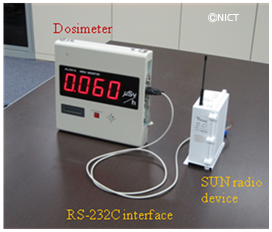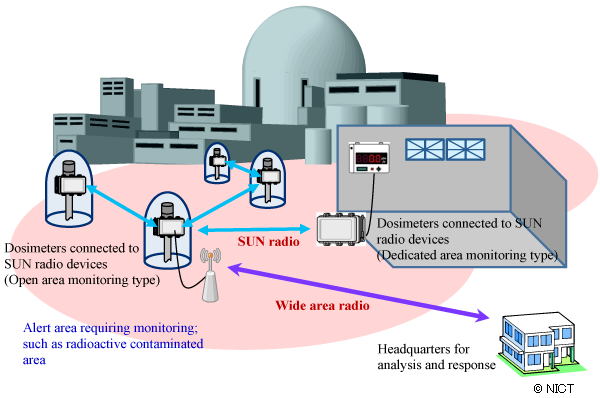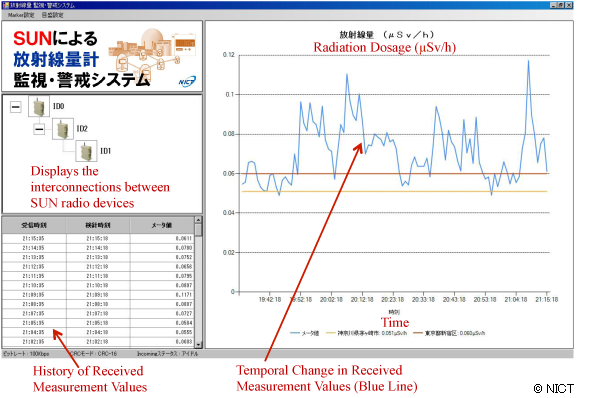Home > Press Release > Proof test on monitoring of radiation dosage utilizing smart meter system
- Radio system compliant with the standard draft for smart utility networks; Long-term monitoring through low-power operation in a world first -
The National Institute of Information and Communications Technology (NICT, President: Dr. Hideo Miyahara) has succeeded in connecting a dosimeter with a radio device for a smart meter to measure radiation dosage on a continuous basis, collect and display temporal changes in the measured values. Through the test, NICT has also demonstrated a means of monitoring radiation dosage without the need for people to enter areas with high levels of radiation.
This radio system which is compliant with the standard draft for smart utility networks (SUN), uses multi-hop transmission to build data collection/circulation topology among meters automatically when it is turned on in the desired service areas. It is also designed to ensure operation and to cope with emergencies when no power is supplied, equipped with a transmission system that achieves reduced power consumption through the effective use of active and inactive periods. This is expected to achieve highly-effective operation for monitoring radiation dosage.

Radioactive contamination in the areas surrounding nuclear power plants due to the incidents caused by major earthquakes is a serious concern. Under such circumstances, it is necessary to monitor radiation dosage and visualize the low levels of contamination on a long-term basis without the need for people to enter such areas as much as possible. On another front, during such disasters and emergencies, some companies that provide critical infrastructure such as electricity, gas and water are unable to use wired connections or electricity.
Recently, the system concept put forth by SUN, which engages in radio-based automated meter-reading, status monitoring and meter control through the application of increasingly sophisticated smart meters, has been attracting a great deal of attention from society as a whole on account of its expanded service area thanks to multi-hop transmission and its low-power operation.
With the inclusion of NICT proposals, work is underway for development of the SUN standard draft specifications as an international standard, because they incorporate the technological components effectively to ensure the required service area for data collection and low-power operation, their effectiveness was expected in monitoring radiation dosage, but until now there had been no cases where dosimeters were connected to SUN radio devices, or no such proof tests were conducted.
In this test, we connected a dosimeter (made by Hitachi Aloka Medical, Ltd.) to a SUN radio device developed by NICT and has succeeded in transmitting periodically-retrieved measurement values through a data frame format compliant with the SUN Standard Draft by IEEE 802 committee. In the proof test, we confirmed the extensibility of the SUN radio transmission service area through multi-hop (two-hop) transmission and also verified low-power operation with the application of an active period of 1 % or less.
This proof test marks a world first in the steady collection and display of temporal changes in radiation dosage using a SUN radio device, and demonstrates a means to monitor radiation dosage without the need for people to enter the areas with high levels of radiation.
The SUN standardization by IEEE 802 committee and the development of domestic radio facility regulations are expected to be completed by the end of fiscal 2011. Using the results from this proof test, NICT hopes to promote the early adoption of the SUN system as it works toward the realization of a safe and secure society that uses ICT.
[Reference] 2011.3.17 “NICT Successfully Conducted the Proof Test On Smart Meter Radio Devices That Enables Low-Power Operations”
<Outline of the assumed system>
●<Figure 1> depicts a conceptual image of radiation dosage monitoring.
The system envisages various types of dosimeter, including those monitoring open areas outdoors and those monitoring designated indoor areas. In each case, the dosimeters are connected to SUN radio devices, and these devices are consolidated into a SUN service area via inter-device multi-hop transmission. The collected data may be further relayed via wide-area communications and transmitted to other sites such as headquarters for analysis and response.

< Utilization of Radio Devices for Smart Meters >
1. Configuration of Wireless Devices and Dosimeters
In this proof test, we used wireless devices compliant with the SUN Standard Draft by IEEE 802 committee.
●<Figure 2> shows the data frame format applied, with the specifications of the radio devices given in <Table 1>.
Within the data frame format, measurement values read each minute from the dosimeter are stored in the ten-octet field of the MAC-layer payload, which is the upper-layer of information. The active period accounts for approximately 0.8% of total time.

during the active period
●<Figure 3> shows the outward appearance of the dosimeter connected to a SUN radio device. The specifications for the dosimeter are given in <Table 2>.

| Size | 28cm × 30cm × 5.5cm |
| Type of Radiation Measured | Gamma Radiation |
| Detector | Silicon Semiconductor Detector |
| Measurement Energy Range | 50 keV - 6 MeV |
| Measurement Range | 0.1 - 999.9 μSv/h |
2. A proof test on the developed radio device
●<Figure 4> shows the configuration of SUN radio devices and dosimeters in the proof test.
Multi-hop (two-hop) transmission was achieved through three SUN radio devices (dosimeter-side terminal, relay terminal and display terminal). Using the final-stage radio device, we displayed radiation dosage measurement values received as a SUN signal on a PC screen.

●<Figure 5> shows the display screen for radiation dosage measurement values in the proof test. As indicated in Figure 4, radiation dosage measurement values read in one-minute intervals by the dosimeter-side terminal are transmitted sequentially in accordance with the data frame format shown in Figure 2. Of the received data frames, the display terminal determines which frames contain errors based on the FCS (Frame Check Sequence). The radiation dosage measurement values read from the remaining frames are then plotted on a time axis on the display PC. As a result of the proof test, we were able to confirm that radiation dosage measurement values can be properly received using the SUN system.

smart meter
smart utility networks (SUN)
IEEE 802 Committee Website
active and inactive periods
Technical Contact
Smart Wireless Laboratory,
Wireless Network Research Institute
Tel: +81-46-847-5084
E-mail: 
















E-mail: 


















Media Contact
Public Relations Department
Tel: +81-42-327-6923
Fax: +81-42-327-7587
E-mail: 

























